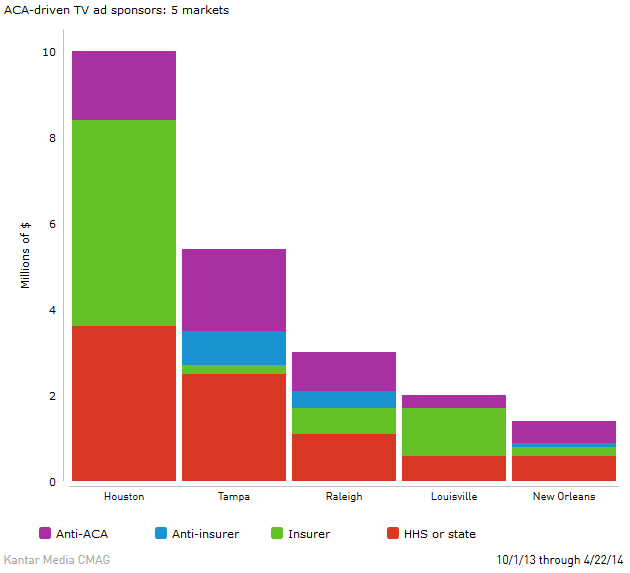MBPT Spotlight: Health Care Law’s Ad Traffic Jam

The Affordable Care Act has been an unprecedented event in U.S. television advertising for basically two reasons.
First, for the never-before-seen, lopsided negative political ad onslaught it has inspired since President Obama signed the ACA into law. From March 23, 2010 through late April 2014, Kantar Media CMAG tracked $445 million in total estimated broadcast and national cable TV ad spending about the law with a negative-to-positive ratio of more than $15 to $1, or $418 million to $27 million.
And second, for the equally unprecedented ushering of millions of consumers into the marketplace at one time—when has a law ever created an instant customer pool like this?—that triggered an insurer and government ad spending spree. From the start of open enrollment on October 1, 2013 until it ended in April 2014, per CMAG, insurers spent close to $400 million on broadcast and national cable TV.
While some insurers’ spending focused on unrelated events such as Medicare deadlines, it’s safe to assume that a significant amount of the spend—and considerably more than the nearly $90 million CMAG tracked for advertising specifically referencing the ACA—was taking advantage of health care reform. Even while avoiding mention of the politically unpopular ACA, some insurers, such as Cigna with its “Go You” campaign, used the enrollment window to roll out new branding. The crash of the federal website and problems with some state sites no doubt unnerved some insurers and altered marketing plans.
In Q4 2013, the only major insurer to spend significantly on advertising that openly acknowledged the arrival of health care reform was Blue Cross Blue Shield via many of its regional organizations. Beyond the Blues, smaller insurers, including new co-ops, were much quicker to use the existence of health care reform in their advertising than the large ones, seeing it as an opportunity to compete with the major brands on a level field.
Yet these insurers’ messages were hardly positive about health care reform as they sought to leverage consumers’ confusion, anxiety and concerns about the changes into direct sign-ups. “Uncertain or scared about your changing health care?” they basically asked. “Come to us for answers.”
The run-up to enrollment and the enrollment window also triggered more than $100 million in TV ad spending by the federal government and state-run exchanges in their campaigns to encourage sign-ups.
Broadcasting & Cable Newsletter
The smarter way to stay on top of broadcasting and cable industry. Sign up below
Millions in negative political ads trying to deter consumers from signing up. Millions in positive government ads trying to encourage people to sign up. Millions in insurer ads trying to play off people’s anxieties to encourage sign-ups—with them. And to top it off: a few million dollars in political ads attacking insurers for allegedly denying coverage or charging women more, a trend started by Democrats seeking to counter Republican attacks on them for supporting the ACA.
So what did it all look like, this buying-and-messaging traffic jam? A number of the nation’s DMAs saw healthy doses of all these types of ad spending. The chart above depicts enrollment-window ad spend in five markets—Houston; Tampa; Raleigh, N.C.; Louisville, Ky.; and New Orleans—which, according to the firms Civis Analytics and GMMB, are all home to populations that are at least 20% uninsured (in Houston’s case, that figure tops 30%).
But it’s not just that all these types of advertisers were active in the same markets—they were advertising during the same genres of programming. All five advertiser types bought talk shows as one of their top-three genres; four of five bought local news. Here are the three most-bought genres for each, per CMAG:
Anti-ACA political: #1 local news, #2 news forum/interview, #3 talk
Anti-insurer political: #1 local news, #2 talk, #3 news forum/interview
State exchange: #1 local news, #2 talk, #3 news forum/interview
USDHHS: #1 talk, #2 sitcom, #3 slice of life
Insurer: #1 talk, #2 local news, #3 slice of life
Of course, these advertisers bought where the customers—and voters—are. But given the resulting traffic jam, we’ll be interested to see whether buying strategies change for the second enrollment period, which starts this November. With Republicans making health care reform a major issue in their 2014 election advertising, will any government or insurer advertisers even venture to try advertising—especially on local news—prior to Election Day, Nov. 4? Will the country’s uninsured even know about the next open enrollment period more than 11 days before it starts?
Conversely, after Election Day, advertisers seeking sign-ups could have their preferred programming to themselves.
Wilner is editor of Kantar U.S. Insights. She is also General Manager of Kantar Media’s Campaign Media Analysis Group (CMAG), which tracks political advertising. She is a former political director of NBC News.
